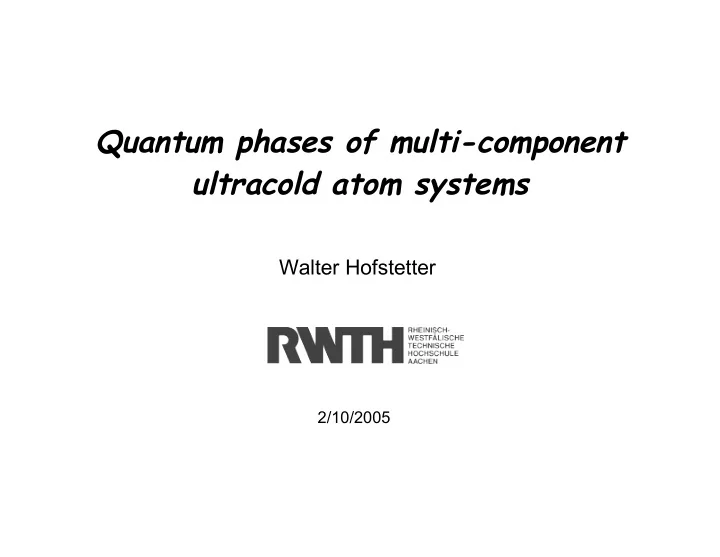

Quantum phases of multi-component ultracold atom systems Walter Hofstetter 2/10/2005
In collaboration with: Carsten Honerkamp Max-Planck-Institute for Solid State Research, Stuttgart, Germany Krzysztof Byczuk Warsaw University, Poland Dieter Vollhardt Augsburg University, Germany
Introduction condensed matter physics atomic physics + ultracold atoms: degenerate quantum gases = Bose-Einstein condensate Ketterle ‘95 New laboratory for correlated many-body systems
Quantum statistics Bosons Fermions condensate Fermi sea 7 Li 6 Li Truscott et al., Science ‘01 Fermi pressure due to Pauli principle
Tunable interactions � multiple scattering channels (hyperfine states) � degeneracy between open and closed channel � large effective scattering length Feshbach resonance Cornish et al., PRL ‘00
Optical lattices � standing light wave: 1d artificial crystal for atoms � theoretical description: I. Bloch, ‘04 Jaksch et al ., ‘98 Hubbard model
Effective model � low filling per site � single Bloch band approximation � tight-binding basis Jaksch et al., ‘98 “recoil energy” Hubbard model strongly correlated atoms
Disorder vs. Interaction � interactions + disorder: Anderson-Hubbard Hamiltonian random, � random optical lattices: Horak et al ., � speckle laser PRA ‘98 � quasiperiodicity (Guidoni et al ., PRL ‘97) � random heavy “impurity” atoms Anderson localization due to impurity backscattering
Why care? � e.g. 2d metal-insulator transition in doped Si-MOSFETS � scaling theory of localization (Abrahams et al.): no metallic state possible for 2d noninteracting electrons with disorder interplay of interaction and disorder? (Kravchenko et al., Pudalov et al., 1995 - )
Fermionic Mott Isolator � pure system ( � =0) at half filling n � + n � =1 delocalized, Fermi liquid localized, Mott insulator transition at U ~ bandwidth
Anderson localization � disordered system, no interactions (U=0) onsite disorder � coherent backscattering leads to localization extended states localized d>2 return probability
Local DOS local DOS measures what is a good criterion for localization? escape rate from given site Fermi’s golden rule insulator metal typical LDOS vanishes in insulator: order parameter
Typical LDOS � LDOS: random quantity, with probability noninteracting � close to localization: log-normal distribution localized Schubert extended et al. ‘05 typical DOS: order parameter Dobrosavljevic et al., EPL ‘03 mean-field theory for Anderson transition
Dynamical Mean-Field Theory K. Byczuk, WH , D. Vollhardt, PRL 94 , 056404 (`05) � interacting lattice model self-consistent local problem Kotliar, Vollhardt, Physics Today 57 , 53 (‘04) effective impurity fermionic “bath” � stochastic DMFT uses typical DOS as mean field order parameter nonperturbative approach to disorder + interaction
DMFT: details K. Byczuk, WH , D. Vollhardt, PRL 94 , 056404 (`05) � start off with interacting lattice model � effective action through “cavity” method � map onto self-consistent Anderson impurity model (here: ensemble!) impurity hybridization conduction band
DMFT: more details � obtain impurity LDOS and calculate local Green’s function (here: typical ) � determine local selfenergy from Dyson equation hybridization � Hilbert transform yields local lattice GF � self-consistency: iterate to convergence
DMFT: even more details � DMFT becomes exact as d �� � successful description of pure fermionic Mott transition Kotliar, Vollhardt, Physics Today 57 , 53 (‘04)
Impurity solver: Numerical RG Wilson, Rev. Mod. Phys. 47 , 773 (`75) � quantum impurity problems Hofstetter, PRL 85 , 1508 (`00) � bosonic and fermionic � separation of energy scales: logarithmic discretization � iterative diagonalization � linear chain Hamiltonian � dynamics: DM-NRG non-perturbative approach
Stochastic DMFT: Results � spectral DOS as a function of interaction U and disorder � re-entrant metallic behavior interaction + disorder = delocalization
Phase diagram K. Byczuk, WH , D. Vollhardt, PRL 94 , 056404 (`05), see also PRB 69 , 045112 (‘04) Detection: � “metal” vs. insulator: Mott and Anderson insulators Fermi surface/incoherent peak continuously connected � Mott insulator has AFM spin order
Binary disorder K. Byczuk, WH , D. Vollhardt, PRB 69 , 045112 (2004) x: density of defects e.g. random impurity atoms Mott transition at noninteger filling � =x quarter filling
Binary disorder K. Byczuk, WH , D. Vollhardt, PRB 69 , 045112 (2004) antiferromagnetism suppressed paramagnetic Mott insulator
Beyond solid-state C. Honerkamp, WH , PRL 92 , 170403 (‘04) and PRB 70 , 094521 (‘04) � electrons can only have spin 1/2: 6 Li a s =-2160a 0 � atoms have many hyperfine states Houbiers et al . ‘97 SU(N) Hubbard flavor index m=1,2,3,… total particle # on site i
SU(N) fermions, repulsive N=3 N=8 � funktional RG: dominant instability spin-1/2 (N=2): N>2: N>6: antiferromagnetism flavor density wave staggered flux
U<0: “Color” superfluid C. Honerkamp & WH , PRL 92 ,170403 (‘04) and PRB 70 , 094521 (‘04) � 3-color fermions: pairing � symmetry breaking 8+1 3+1 generators unpaired � degenerate ground state Leggett `97 SU(3)-triplet
SU(3) superfluid coexistence of SC and normal Fermi liquid
Pairing fluctuations amplitude fluct. Landau damping � 12 � 13/23 � SU(3) symmetric 5 gapless modes � SU(3) broken: � 13 � 23 only 1 Goldstone mode: � 12 phase
“Color” superfluid flavor mode � 123 = � 1 + � 2 -2 � 3 experimental signature: density response Anderson- Bogoliubov phase mode Bragg scattering new “exotic” quantum state in cold atom system 3-color “toy model” for QCD
Summary optical lattices BEC exotic quantum states disorder quantum simulations
Recommend
More recommend